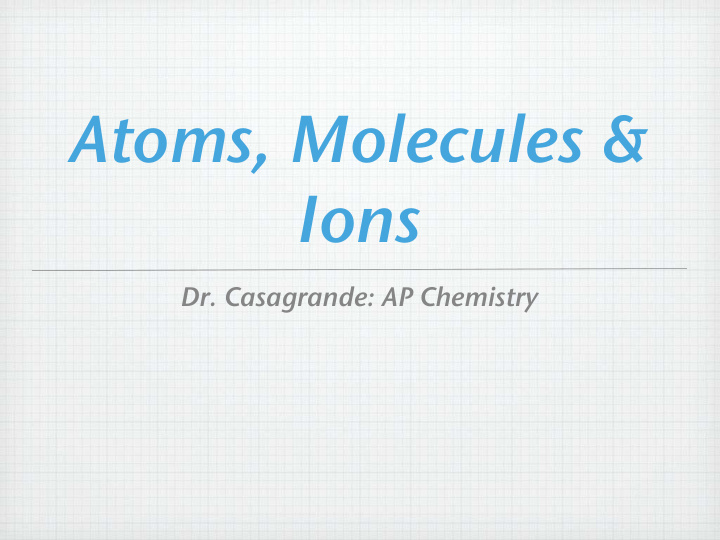



Atoms, Molecules & Ions Dr. Casagrande: AP Chemistry
Naming ionic compounds Has metal and nonmetal or polyatomic ion Monatomic cations (metals) named as element Roman numerals indicate charge for all metals other than Group 1, 2, Al 3+ , Cd 2+ , Zn 2+ , Ag + Obtain charge from formula & anion charge Monatomic anions (nonmetals) take element name with –ide ending Don’t need to memorize polyatomic ions Most polyatomic anions end in –ate or –ite Most common: NO 3– , SO 42– , CO 32– , PO 43– Polyatomic cations: NH 4+ (ammonium) & Hg 22+ [mercury (I)] e.g. NaI: sodium iodide Fe 2 (SO 4 ) 3 : iron(III) sulfate (iron has a +3 charge since sulfate is a –2)
Formulas of Ionic Compounds Write symbol/formula of cation from periodic table or polyatomic ion chart Write symbol/formula of anion If ends in –ide usually monatomic ion If ends in –ate or –ite must be polyatomic ion Write charges on ions, then criss-cross to make neutral Enclose polyatomic ions in parens if more than one in formula Erase charges or rewrite without charges e.g. calcium hydroxide: Ca 2+ OH 1– Ca(OH)2 nickel(III) bromide: Ni 3+ Br 1– NiBr3
Names & Formulas of Molecular Compounds 2 non-metals First element named, second element has –ide ending Usually arranged with higher electronegativity element 2 nd Use Greek prefixes to indicate number of each atom: mono, di, tri, tetra, penta, hexa, hepta, octa, nona, deca e.g. N 2 O 5 : dinitrogen pentoxide CO: carbon monoxide (note: only use “mono” for second element) sulfur hexafluoride: SF 6 tetraphosphorous decoxide: P 4 O 10
Naming & Formulas of Acids Start with H + , paired with anion Need 1 H + for each negative charge Binary acids (no O) use hydro– prefix, –ic suffix: HCl: hydrochloric acid, HCN: hydrocyanic acid Hydrosulfuric acid: H 2 S; Hydroiodic acid: HI For oxoacids, polyatomic anion determines name: –ate ➯ –ic (no hydro), –ite ➯ –ous: HClO (HOCl): hypochlorite ➯ hypochlorous acid HNO 3 (HONO 2 ): nitrate ➯ nitric acid Phosphorous acid: H 1+ PO 33– ➯ H 3 PO 3 Perbromic acid: H 1+ BrO 41– ➯ HBrO 4
Hydrates Ionic compounds with H 2 O molecules bound within lattice Use Greek prefixes to indicate number of H 2 O molecules: CaCl 2 · 2 H 2 O: calcium chloride dihydrate CuSO 4 · 5 H 2 O: copper(II) sulfate pentahydrate
Recommend
More recommend